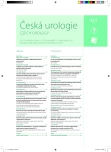Positron emission tomography and histology of residual postchemotherapy masses in patients with nonseminomatous germ cell tumours
Authors:
Jana Grimová 1*; Tomáš Büchler 1*; Pavel Fencl 2; Kateřina Šimonová 2; Zuzana Donátová 1; Ludmila Boublíková 1; Martin Kupec 1; Jaroslav Jarabák 3; Roman Zachoval 3; Jitka Abrahámová 1
Authors‘ workplace:
Onkologická klinika Thomayerovy nemocnice a 1. lékařské fakulty Univerzity Karlovy, Praha
1; Oddělení nukleární medicíny a PET centrum, Nemocnice Na Homolce, Praha
2; Urologické oddělení Thomayerovy nemocnice, Praha
3
Published in:
Ces Urol 2012; 16(1): 43-49
Category:
Original article
*přispěli stejným dílem
Overview
Aim:
The value of using fluorodeoxyglucose positron emission tomography (FDG-PET) before residual mass resection was studied in patients with nonseminomatous germ cell tumours (NSGCTs) after orchiectomy and platinumbased chemotherapy.
Methods:
Thirty patients with NSGCTs who had been investigated with FDG-PET in the preoperative period were evaluated retrospectively. We have calculated specificity, sensitivity, positive predictive value (PPV) and negative predictive value (NPV) of FDG-PET to correctly predictt he presence of viable carcinoma, mature teratoma,and necrotic/ scar tissue in postchemotherapy residual masses.
Results:
FDG-PET was evaluated as negative, positive, or inconclusive in 11 (37%), 17 (57%) and 2 (7%) patients, respectively. Histological examination of the resected residual masses showed immature tumour elements, mature teratoma, and no tumour structures in 12 (40%), 11 (37%), and 7(23%) patients, respectively. FDG-PET correctly identified only 50% of lesions with immature tumour elements. FDG-PET was negative in 13/21 (62%) patients with immature elements and/or mature teratoma – histologies that require surgical resection because of high risk of relapse.
Conclusions:
Sensitivity, specificity, PPV, and NPV of FDGPET were insufficient for characterisation of postchemotherapy residual lesions in NSGCT patients. These residual masses should be resected if technically possible regardless of the FDG-PET result.
Key words:
positron emission tomography, testicular cancer, therapy.
Sources
1. Dušek L, Mužík J, Gelnarová E, et al. Cancer incidence and mortality in the Czech Republic. Klin Onkol 2010; 23: 311–324.
2. Dušek L, Mužík J, Büchler T, Abrahámová J. Současné trendy v epidemiologii zhoubných nádorů varlete v ČR a predikce na rok 2012. In: Vybrané otázky onkologie XV. – 19. onkologicko-urologické sympozium a 15. mammologické sympozium. Praha 2011: 12–14.
3. Büchler T, Šimonová K, Fencl P, Abrahámová J. Pozitronová emisní tomografie v diagnostice a sledování pacientů s neseminomovými germinálními nádory. Klin Onkol 2011; 24: 413–417.
4. Povýšil C. Patomorfologie nádorovitých afekcí a nádorů varlete a paratestikulárních struktur. In: Abrahámová J, Dušek L, Povýšil C. a kol. Nádory varlat. Praha: Grada Publishing 2008; 93–120.
5. Fosså SD, Qvist H, Stenwig AE, et al. Is postchemotherapy retroperitoneal surgery necessary in patients with nonseminomatous testicular cancer and minimal residual tumor masses? J Clin Oncol 1992; 10: 569–573.
6. Bosl GJ, Motzer RJ. Weighing risks and benefi ts of postchemotherapy retroperitoneal lymph node dissection: not so easy. J Clin Oncol 2010; 28: 519–521.
7. Schmoll HJ, Jordan K, Huddart R, et al. Testicular seminoma: ESMO Clinical Practice Guidelines for diagnosis, treatment and follow-up. Ann Oncol 2010; 21(Suppl 5): v 140–146.
8. Albers P, Albrecht W, Algaba F, et al. EAU guidelines on testicular cancer: 2011 update. Eur Urol 2011; 60: 304–319.
9. De Santis M, Becherer A, Bokemeyer C, et al. 2-18fl uoro-deoxy-D-glucose positron emission tomography is a reliable predictor for viable tumor in postchemotherapy seminoma: an update of the prospective multicentric SEMPET trial. J Clin Oncol 2004; 22: 1034–1039.
10. Kollmannsberger C, Oechsle K, Dohmen BM, et al. Prospective comparison of (18F) fluorodeoxyglucose positron emission tomography with conventional assessment by computed tomography scans and serum tumor markers for the evaluation of residual masses in patients with nonseminomatous germ cell carcinoma. Cancer 2002; 94: 2353–2362.
11. Oechsle K, Hartmann M, Brenner W, et al. (18F)Fluorodeoxyglucose positron emission tomography in nonseminomatous germ cell tumors aft er chemotherapy: the German multicenter positron emission tomography study group. J Clin Oncol 2008; 26: 5930–5935.
12. Karapetis CS, Strickland AH, Yip D, et al. Use of fl uorodeoxyglucose positron emission tomography scans in patients with advanced germ cell tumour following chemotherapy: single-centre experience with long-term follow up. Intern Med J 2003; 33: 427–435.
13. Chocholatý M, Dušek P, Kawaciuk I, et al. Korelace pozitronové emisní tomografi e, CT a histologie po retroperitoneální lymfadenektomii u nemocných s germinálním nádorem. In: Abrahámová J (ed). Vybrané otázky onkologie XI. Praha: Galén 2007; 46–48.
14. Havránek O, Krhut J, Kopecký J, Hájek J. Výsledky pozitronové emisní tomografi e před retroperitoneální lymfadenektomií u pacientů s metastatickým testikulárním nádorem neseminomového typu. Česká urologie 2008; 12(2): A51.
Labels
Paediatric urologist Nephrology UrologyArticle was published in
Czech Urology

2012 Issue 1
Most read in this issue
- Complications associated with indwelling urethral catheter aft er major joint arthroplasty in men
- How safe is active surveillance strategy of small renal masses?
- Use of neuromodulation in the treatment of lower urinary tract dysfunction
- Bilateral adrenalectomy – in patients with Cushing’s syndrome due to ectopic secretion of ACTH
